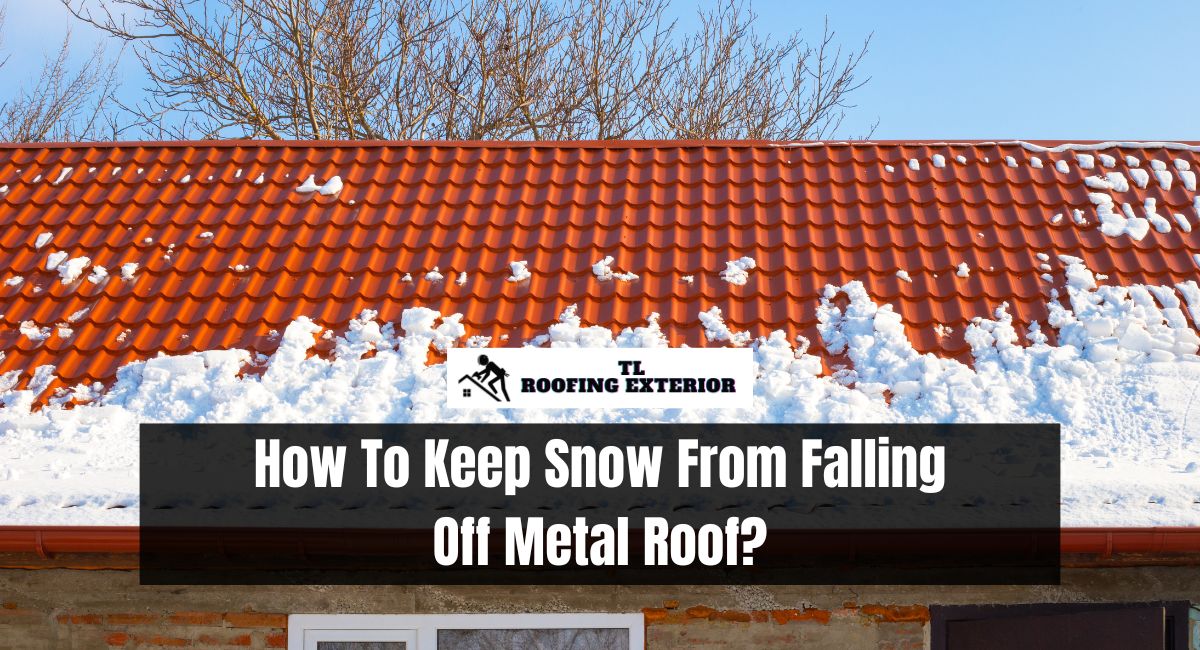Metal roofs are highly regarded due to their resilience, energy efficiency, and elegant appearance. However, an issue that can arise, especially in colder climates, is the abrupt and potentially hazardous loss of accumulated snow. Snow that slides off a metal roof can endanger humans, animals, and property below.
So, how can you experience the benefits of a metal roof while mitigating the dangers of snowfall?
This article will discuss numerous methods and devices for preventing snow from sliding off a metal roof, thereby enhancing safety and peace of mind.
How To Keep Snow From Falling Off Metal Roof?
Snow sliding off a metal roof can be a hazard, potentially damaging property or injuring people below. Here are some methods to help prevent snow from falling off your metal roof:
Snow Guards
- Pad-Style Snow Guards: These are small “pads” or “cleats” that are installed in staggered rows to hold the snow on the roof and allow it to melt or evaporate gradually.
- Material: Often made of polycarbonate or metal, these are durable and designed to withstand the elements.
- Placement: The placement is crucial; they are usually installed in a staggered pattern across the roof to evenly distribute the snow’s weight.
- Effectiveness: Best for lighter snow loads and smaller roofs.
- Pipe-Style Snow Guards: These are rails that run horizontally across the roof. They are more effective for heavier snow loads.
- Material: Typically made of strong metals like stainless steel or aluminum.
- Design: Consists of pipes or bars that run horizontally across the roof, often supported by brackets.
- Effectiveness: Suitable for heavier snow loads and larger roof areas.
- Clamp-On Snow Guards: These are designed for standing seam metal roofs and clamp onto the seams without penetrating the roof material.
- Material: Usually made of metal.
- Installation: These are clamped onto the roof’s standing seams, avoiding any need for penetrations that could lead to leaks.
- Effectiveness: Good for moderate to heavy snow loads, particularly on standing seam metal roofs.
Snow Fence or Snow Rail
- Roof-Mounted Snow Fence: This is a stronger and more permanent solution than snow guards. A snow fence runs horizontally along the edge of the roof and is designed to hold larger amounts of snow.
- Material: Often made of high-strength metal or sometimes heavy-duty plastic.
- Design: Usually consists of a mesh or slatted design to hold back snow while allowing wind to pass through.
- Effectiveness: Highly effective for larger roofs and heavier snow loads.
- Snow Rail: Similar to a snow fence but usually made of a metal rail rather than mesh or netting.
- Material: Typically made of metal.
- Design: Similar to a snow fence, it usually consists of a solid metal rail.
- Effectiveness: Good for moderate to heavy snow loads and offers a sleeker appearance.
Snow Retention Netting
- Netting: Specialized netting can be installed over the roof to hold back snow, although this is less commonly used and may detract from the appearance of the roof.
- Material: Made of heavy-duty fabric or plastic mesh.
- Design: Covers the entire roof or specific areas needing snow retention.
- Effectiveness: Less commonly used and may not be as effective or aesthetically pleasing as other options.
Roof Design
- Roof Pitch: A less steep pitch can reduce the speed at which snow slides off the roof.
- Design Considerations: A roof with a pitch between 3:12 and 4:12 is generally less likely to shed snow suddenly compared to steeper designs.
- Effectiveness: Effective but may require structural changes to the roof, making it a more involved solution.
- Rough Surface: Some metal roofs are available with a rough surface that can help to grip the snow and prevent it from sliding off as easily.
- Material: Some metal roofing materials come with a textured surface.
- Effectiveness: The textured surface can provide additional friction to hold back snow, but its effectiveness can vary.
Other Considerations
- Local Building Codes: Before installing any snow retention system, check your local building codes to ensure you’re in compliance.
- Importance: Compliance with local building codes is crucial to ensure safety and legality.
- Consultation: Always consult local authorities or a professional to understand the requirements.
- Professional Installation: For best results, consider hiring a professional to install snow guards or a snow fence. Incorrect installation can result in roof damage or ineffective snow retention.
- Importance: Incorrect installation can lead to roof damage or ineffective snow retention.
- Expertise: Professionals have the expertise to install these systems correctly and safely.
- Regular Inspection: Whichever method you choose, regular inspection is crucial to ensure that it remains effective and in good condition.
- Frequency: At least twice a year, before and after winter.
- Purpose: To check for any wear and tear or loosening of components.
- Consult a Structural Engineer: Adding a snow retention system will increase the load on your roof. Consult a structural engineer to ensure your roof can handle the additional weight.
- Importance: Adding weight to your roof could compromise its structural integrity.
- Assessment: A structural engineer can assess whether your roof can handle the additional load.
Conclusion
Preventing snow from cascading off a metal roof is a crucial safety measure that requires careful planning and the proper tools. Snow barriers and snow retention systems are the most effective solutions, as they are designed to keep snow in place until it can melt and drain away gradually.
The type and configuration of these devices are determined by a number of variables, including the roof’s pitch, the type of metal roofing material, and the local snow load conditions. Despite the availability of do-it-yourself options, it is often advisable to consult with professionals to ensure a secure and effective installation.
Read More: What Is Oil Canning On A Metal Roof?
